国務省出版物
米国の統治の仕組み – 連邦政府
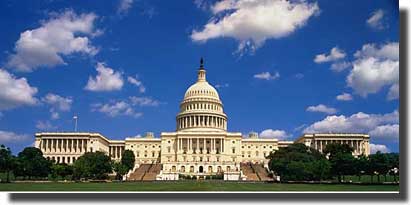
首都首都ワシントンにある連邦議会議事堂は、長い間、米国の代議政治を象徴する存在となってきた。上院と下院の2つの議院に分かれており、新しい法律が効力を持つためには両院が合意する必要がある。
連邦政府は3 つの別個の部門、すなわち立法府、行政府、司法府から成り、各々が明確に定められた憲法上の権限と責任を有している。
連邦政府の立法府は、2 つの議院から成る連邦議会である。すなわち、連邦上院と連邦下院である。法案は、両院を通過しなければならない。その後で大統領に送付され、その署名により成立する。
毎年、何千件もの法案が連邦議会に提出されるが、成立するのは数百件に過ぎない。法案が起草され、最終的に大統領の署名により法律となるまでの大まかな流れを以下に示す。
1.法案が作成される。上院議員または下院議員が法案を起草する場合もあれば、業界団体や一般市民が法案の作成を要請し、その起草を手伝う場合もある。ただし、実際に法案を提出できるのは上院議員または下院議員のみである。法案を書き上げると、その起草者は、自分の主張に重みを加えるため、共同提出者となる議員を集める。
2.法案が上下両院、あるいはそのどちらかに提出される。法案には番号がつけられ、法案の名前と提出者が連邦議会議事録に記載される。
3.上院および下院のパーラメンタリアン(議会運営手続きの専門員)が、法案を適切な権限を有する委員会に付託する。その委員会の委員長は、最もふさわしい小委員会に法案を付託する。特筆すべき点は、付託された法案をどう審議するかに関して、委員長と小委員長が大きな権限を持つことである。この2人は、法案に反対であれば、何もしないことが可能である。
4.小委員会は法案に関する公聴会を開催し、公共部門や民間の証人に証言させることができる。証人は、行政府職員、専門家、業界団体・労働組合・学界・公益団体・経済界の関係当事者などである。個人が証言を行ったり、意見書を提出したり、利益団体に意見を代弁させたりして、自らの見解を明らかにする場合もある。
5.公聴会が終了すると、小委員会は会議を開いて法案の「マークアップ(仕上げ)」を行う。マークアップとは、作成された法案に対する修正を提案・検討する作業である。マークアップに続いて、本委員会に賛成の報告を行うべきか否かについての採決を行う。賛成の報告が行われない場合、法案は廃案となる。
6.委員会では、小委員会と同じ手続き(公聴会、マークアップ、採決)のうちの一部、またはすべてが行われることもある。委員会が法案に賛成した場合には、下院本会議または上院本会議(いずれか審議を行う方)に法案を報告することが決定される。
7.法案が下院本会議または上院本会議まで進むと、下院または上院の全議員で審議する。この段階で法案は、①さらに修正される②委員会へ再び付託される③あるいは採決が行われる―のいずれかになる。
8.下院または上院で可決されると、法案は他方の議院に付託される。下院で可決された法案は、小委員会や委員会での審査を行わずに、直接、上院の議事日程表に掲載される場合もある。しかし通常は、両院とも、小委員会と委員会が公聴会を開催し、法案を修正する機会がある。関連する法案や同じような法案については、下院と上院での審議が、しばしば同時に行われる。
9.同一の文面で下院と上院を通過した場合、法案は大統領に送付される。下院と上院で法案の文面に相違がある場合には、これを解消するため、上院議長と下院議長によって両院協議会が任命される。協議会で合意に達することができなければ、法案は廃案となる。合意に達した場合は、法案は両院に差し戻される。両院は、法案にそれ以上の修正を加えず、そのまま採決しなければならない。
両院協議会で合意した法案が両院で可決された場合には、署名を得るために大統領に送付される。大統領には4つの選択肢がある。①法案に署名して法律にする②連邦議会の開会中に何の行動も取らない。この場合、10日が経過するとその法案は法律となる③連邦議会が休会中に何の行動も取らない。この場合、法案は廃案となる④法案に拒否権を行使する。
大統領が法案を拒否した場合、連邦議会は大統領の拒否権を覆すことを試みることができる。拒否権を覆すには、上下両院で3 分の2 以上の賛成が必要となる。いずれかの議院で3 分の2 の賛成が得られなければ法案は廃案となり、両院とも3 分の2 に届けば法案は成立する。
法律制定に加え、連邦議会の最も重要な活動のひとつとなっているのが、行政府の監視である。連邦議会は、行政府に法律を誠実に履行させるため、行政府の業務や活動を調査するための公聴会を開催することができる。
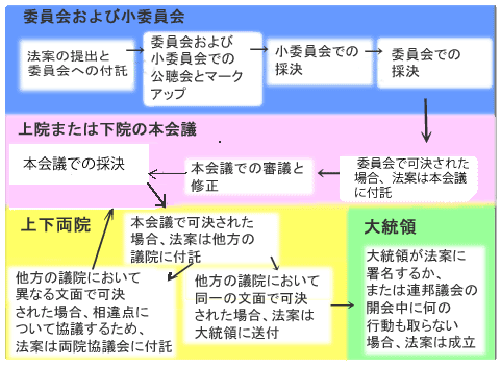
- 「Upper Chamber(上位の議院)」 と見なされ、下院よりも審議機能が高いと考えられている。
- 100 人(各州から2人)の上院議員で構成される。
- 上院議員の任期は6 年で、務める任期の数に制限はない。
- 選出の便宜のため、上院議員は3 つのグループに分けられ、1 つのグループが2年ごとに改選される。この仕組みにより、経験のある現職議員が常に確保されるようになっている。
- 上院議員に欠員が生じた場合には、通常、欠員の出た州の知事の任命によって補充される。
- 副大統領が上院議長を務め、可否同数の場合のみ票を投じる。
注1
注1実際には、可否同数となる事例はほとんどなく、副大統領が上院議長職を務めるのはごく限られた場合だけである。副大統領の不在時には、上院は、日々の議事進行を主宰する議長を上院議員の中から選出する。
下院と同じ広範な立法権を有するが、上院のみに付与されている権限もある。すなわち、
- 連邦最高裁判所と連邦下級裁判所、行政府の主要な役職の大統領による指名人事は、被指名者の就任に先立って上院が承認を与えなければならない。
- 上院は、大統領が取り決めた国際条約を可決または否決する。
- 大統領または連邦最高裁判所裁判官が弾劾訴追された場合には、上院本会議が弾劾裁判を行い、陪審として機能する。
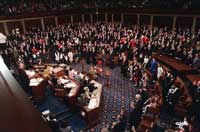
1989年1月、連邦議会議事堂の下院会議場で就任宣誓を行う下院議員たち
下院(House of Representatives)
1989年1月、連邦議会議事堂の下院会議場で就任宣誓を行う下院議員たち
- 「House of the People(人民の議院)」 と見なされる。
- 435 人の下院議員で構成され、議席数は人口に応じて各州に割り振られる。5 つの準州と属領、すなわちコロンビア特別区(首都)、米領サモア、グアム、プエルトリコ、米領バージン諸島からも、投票権のない代表者が選出される。
- 下院議員の任期は全員2 年で、任期の数に制限はなく、全員が同時期に選出される。
- 各議員は、下院選挙区と呼ばれる州内の特定区域から、1 人ずつ議員が選出される。
- 下院議員に欠員が生じた場合には、補欠選挙または総選挙によってのみ補充される。
- 下院議員は下院議長を選出する。下院議長は下院の統括者であり、実際には多数党に所属する。
上院と共有することなく下院だけに付与されている特別な権限および責任として、以下に示すものが含まれる。
- 大統領と連邦最高裁判所裁判官に対する弾劾訴追を行う権限。
- 歳入の徴収に関するすべての法案は、まず下院に提出されなければならない。
- いずれの大統領候補者も選挙人票の過半数を獲得しなかった場合、下院が大統領を選出する。この場合、各州の議員団はそれぞれ1 票を有する。
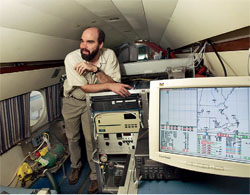
連邦政府諸機関は、事業を立案すると同時に情報収集を行う。このエネルギー省の科学者は、航空機を利用してニューイングランドの大気汚染に関する情報を収集している
行政府は、連邦政府の中でも突出して大きな部門である。行政府の長は大統領で、その任期は4 年である。副大統領も大統領と一緒に選出され、大統領が死亡した場合、執務不能となった場合、または弾劾裁判で有罪となり免職された場合、副大統領は大統領職を継承する順位で第1 位となっている。
行政府は他の2つの施政部門と同等の権限を分かち合っているが、大統領は、政府の中で最も大きな権力を持つ1 個人である。大統領の権限および役割には、以下に示すようなものがある。
- 連邦最高裁判所と連邦下級裁判所の裁判官を任命する。ただし、いずれも上院の承認を必要とする。
- 各省の長官とその他の政府機関の長から成る内閣を任命する。ただし、上院の承認を必要とする。
- 軍の最高司令官としての役割を果たす。
- 名目上の国家元首としての役割を果たす。
- 国際条約およびインディアン部族との条約を締結する。ただし、いずれも上院の承認を必要とする。
- 連邦議会で可決された法案に対して拒否権を行使する。
- •(弾劾の場合を除き)連邦犯罪に対する恩赦および刑の執行猶予を与える。
上記の憲法上の権限以外にも、実質的に大統領は、非公式の権限や憲法で明確に規定されていない権限を持つ。まず何よりも、大統領は大統領令を発することができる。これは法的拘束力を持つ命令であり、一般に、以下のような目的で行使される。
- 大統領の政治課題を推進・実行するために、新たなプログラムや職責、委員会を設立する。
- 連邦議会で可決された法律の施行方法に影響を及ぼす政策を立案する。
- 連邦政府職員の休日を宣言する。

「ソーシャル・セキュリティー(社会保障)」として知られる老齢年金は、連邦政府によって数百万人に支給されている。上は、ペンシルベニア州フィラデルフィアの財務省財務管理施設で印刷が終わり、郵送されるのを待つ小切手
大統領令は、大統領が政策目標を達成するための強力な道具となり得るもので、この権限は連邦最高裁判所によって支持されてきた。個々の大統領令は、連邦議会での法律制定によって覆したり修正したりできるが、法案が議会を通過しても、大統領が署名しなければ発効しない。ただし、大統領の拒否権が議会で覆された場合は例外である。また、大統領令が憲法に違反するか、または現行法に抵触すると考えられる場合には、法廷で異議を申し立てることができる。
最後に、大統領は自らの所属する政党の党首を務め、大統領の地位と注目度を利用して、一般国民や党員に対して政治的見解を明確にしたり、政治的目標を推進したりできる。
大統領と副大統領の下には15 の省とその他多数の機関が置かれ、われわれが毎日目にしている「政府」を構成している。これらの機関は、法律の管理・執行や種々の行政サービスの提供を担っている。その機能は広範にわたっており、すべての米国民の生活に影響を及ぼしている。
15の省は以下に示すとおりである。
- 農務省(USDA)
- 商務省(DOC)
- 国防総省(DOD)
- 教育省(ED)
- エネルギー省(DOE)
- 保健福祉省(HHS)
- 国土安全保障省(DHS)
- 住宅都市開発省(HUD)
- 内務省(DOI)
- 司法省(DOJ)
- 労働省(DOL)
- 国務省(DOS)
- 運輸省(DOT)
- 財務省
- 復員軍人省(VA)
各省を率いる長官は、大統領によって任命されるが、上院の承認を必要とする。各省の長官は法律により大統領内閣を組織する。大統領内閣は、自らの責務に関連するあらゆる問題について大統領に助言する一団である。大統領は、行政府のその他の最高幹部にも閣僚レベルの地位を付与することができる。通常この中には、副大統領、大統領首席補佐官、行政管理予算局長、通商代表が含まれる。そのほか、現在または近年、閣僚レベルとされている役職に、環境保護局長官、中央情報局長官、国家安全保障担当大統領補佐官がある。
各省に加えて、多数の独立した局や委員会などが行政府を構成しており、中には非常に大きな機関もある。例として、米国郵政公社、環境保護局、航空宇宙局(NASA)などが挙げられる。
規制機関は特に大きな影響力を持っている。規制機関は、経済の特定の側面を管理する規則を策定・施行する権限を議会から付与されており、専門的で複雑な問題を扱うことが多い。主な規制機関を以下に示す。
- 証券取引委員会(SEC)
- 連邦取引委員会(FTC)
- 原子力規制委員会(NRC)
- (保健福祉省の)食品医薬品局(FDA)
- 連邦通信委員会(FCC)
- 環境保護局(EPA)
- 雇用機会均等委員会(EEOC)
- (労働省の)職業安全衛生管理局(OSHA)
上記の機関は、その他の規制機関とともに、ほぼすべての企業や消費者に影響を与える規則を制定している。委員会の委員と各機関の長官の任命は大統領が行い、上院の承認を必要とする。規制機関が策定する規則は法的拘束力を持つが、規則に対して法廷で異議を申し立てることや、規則を議会で覆すことが可能である。
独立機関の中でも最も独立性が高いのは、米国の中央銀行に相当し、「Fed(FederalReserve Board)」とも呼ばれる連邦準備制度である。連邦準備制度理事会は、米国の金融政策の策定、金利の設定、通貨供給量の決定を担っている。連邦準備制度の決定は、米国の経済、金利、インフレ、雇用創出、国際貿易に広範な影響を及ぼす。事実、多くの人々が、連邦準備制度理事会議長を、大統領に次ぐ権力者と考えている。
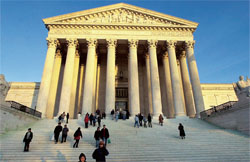
米国の最上級の裁判所を擁する首都ワシントンの連邦最高裁判所の建物。連邦最高裁の9 人の裁判官は、米国の法的問題や憲法問題を解釈する重要な役割を果たす
司法府は、連邦法に異議を申し立てる訴訟や連邦法の解釈を必要とする訴訟の判決を下し、被告人が連邦法違反の罪に問われている刑事事件を審理する。また、連邦裁判所は、州法の憲法上の根拠が問われる場合の上訴管轄権、および2 州以上がかかわる訴訟、2 州以上の市民がかかわる訴訟、あるいは外国人がかかわる訴訟に対する司法権を有する。
司法府は連邦最高裁判所と連邦下級裁判所で構成される。下級裁判所には、控訴裁判所(巡回裁判所、上訴裁判所とも呼ばれる)、連邦地方裁判所、破産裁判所、請求裁判所などがある。連邦裁判所は、州裁判所からの民事・刑事双方の上訴事件を審理する。連邦裁判所の第一審管轄権は、特許権、商標権、連邦政府に対する請求、破産、証券、海事法、国際的請求に関連する訴訟に適用される。
政府の別個の部門として、司法府は他の2つの部門から独立しており、合衆国憲法に定められた抑制と均衡にのみ制約される。司法府の独立性は、すべての国民に公正と平等を保障する上で不可欠であると考えられている。憲法は、主に2つの方法によって、司法府の独立性を高めている。第1に、連邦裁判官は終身制であり、免職されるのは、「反逆罪、収賄罪またはその他の重罪および軽罪」によって連邦議会に弾劾され、有罪の判決を受けた場合のみである。第2に、憲法は、連邦裁判官の報酬の額は「在職中に減らされることはない」と定めているため、大統領も連邦議会も連邦裁判官の報酬を削減することはできない。この2つの方法で司法府が保護されているため、大衆の感情や政治的影響力に左右されずに、独立して判決を下すことが可能になっている。
合衆国憲法の起草者たちは、司法府が政治的圧力や世論による影響を受けない部門となることを想定していたが、裁判官選出の過程は極めて政治的なものとなっている。連邦最高裁判所と連邦下級裁判所の裁判官は、大統領の指名を受け、上院の承認を得て初めて就任できる。
現在、連邦最高裁の裁判官は9 人で、その数は法律で定められている。連邦下級裁判所については、その管轄権、裁判官の人数、予算を含め、連邦議会が定める。すべての連邦裁判官は、その終身職に就くため、上院の承認を得なければならない。ただし、連邦議会の閉会中は、一時的にその職に就く裁判官を大統領が任命できる。保釈金の決定、令状の発行、軽犯罪の審理などを行う連邦治安判事は、連邦地方裁判所の裁判官によって任命され、その任期は8 年である。
国土安全保障省は最も新しく設立された閣僚級の省である。省の設立日は重要な意味を持つ。なぜなら、大統領が死亡したり執務不能となったりした場合には、大統領職は副大統領に継承され、副大統領が大統領職を務めることができない場合には、以下の順位で継承されるからである。
|
The Federal Government
(The following article is taken from the U.S. Department of State publication, How the United States is Governed.)
The federal government is made up of three distinct branches, each with clearly defined Constitutional powers and responsibilities. These are the legislative branch, the executive branch and the judicial branch.
THE LEGISLATIVE BRANCH
The legislative branch of the federal government is comprised of two chambers of Congress: the U.S. Senate and the U.S. House of Representatives. Legislation must pass both houses before it is presented to the President to be signed into law.
How a bill becomes law
Each year, thousands of bills are introduced in Congress, but only a few hundred are passed into law. The following is a summary of how a bill makes its way from draft to being signed into law by the President.
1. A bill is written. A Senator or Representative may draft original legislation, or a trade association or private citizen may request that a bill be prepared and may assist in its writing. Only a Senator or Representative, however, can actually introduce a bill. Once written, the author of the bill will seek co-sponsors from among his or her colleagues to add greater credibility to the initiative.
2. The bill is introduced in the Senate and/or House. It is assigned a number and its title and sponsors are published in the Congressional Record.
3. The Parliamentarians of the House and Senate assign the bill to the committee with appropriate jurisdiction. The chair of the committee may then assign the bill to the most appropriate subcommittee. It is important to note that the committee and subcommittee chairs have a great deal of power over how a bill assigned to them is considered. If the chair opposes the legislation, he or she may simply not act on it.
4. The subcommittee may hold hearings on the bill and invite testimony from public and private witnesses. Many witnesses are Executive Branch officials, experts, or affected parties from trade associations, labor unions, academia, public interest groups, or the business community. Individuals may also make their views known by testifying, by providing a written statement, or by allowing interest groups to represent their views.
5. Once the hearings are completed, the subcommittee may meet to "mark up" the bill, which is the process of proposing and considering amendments to the bill as written. It then votes on whether to report the bill favorably to the full committee. If not favorably reported, the bill dies.
6. The full committee may repeat any or all of the subcommittee's actions: hearings, markup, and vote. If the committee votes favorably on the bill, it is ordered reported to either the full House of Representatives or the full Senate, depending on which chamber is considering the bill.
7. When the bill reaches the floor of the House or Senate, the membership of the entire body may debate it. At this point, the bill may be further amended, referred back to committee, or voted on.
8. If the bill is passed by the House or Senate, it is referred to the other chamber. A House-passed bill may be placed directly on the Senate Calendar, bypassing the subcommittee and committee reviews. Usually, however, the subcommittees and committees in both bodies have an opportunity to hold hearings, and amend the bill. Related or identical legislation often proceeds through the House and Senate simultaneously.
9. If a bill is passed in identical form by the House and Senate, it is delivered to the President. If there are differences between the House and Senate versions of the bill, a conference committee is appointed by the President of the Senate and the Speaker of the House to resolve the differences. If the conferees are unable to reach agreement, the legislation dies. If they do reach an agreement, the bill is sent back to both chambers, which must vote on them without further amendment.
If both chambers approve the conference committee bill, it goes to the President for signature. The President has four options: (1) Sign the bill into law; (2) Take no action while the Congress is in session, in which case the bill becomes law after ten days; (3) Take no action while a Congress is in final adjournment, in which case the bill dies; or (4) Veto the bill.
If the President vetoes a bill, Congress may attempt to override the veto. This requires a two-thirds vote by both the House and Senate. If either fails to achieve a two-thirds majority in favor of the legislation, the bill dies. If both succeed, the bill becomes law.
In addition to creating laws, one of the most important activities of Congress is oversight of the Executive Branch. Congress may hold hearings to investigate the operations and actions of the Executive Branch to ensure that it is carrying out the law with integrity.
The Senate
• Considered the "Upper Chamber," it is considered more deliberative than the House.
• Comprised of 100 Senators (two from each state).
• Senators serve six-year terms, with no limit on the number of terms they may serve.
• For election purposes, senators are divided into three classes; one class stands for election every two years. This ensures that there are always experienced legislators serving in Congress.
• Vacancies in the Senate are generally filled by appointment by the governor of the state where the vacancy exists.
• The Vice President of the United States serves as the President of the Senate, voting only in cases of a tie.
• While sharing broad legislative powers with the House of Representatives, the Senate has several unique powers to itself.
• The Senate must confirm presidential appointments to the Supreme Court, lower federal courts, and key positions within the Executive Branch before the appointees can take office.
• The Senate approves or rejects international treaties negotiated by the President.
• In cases of impeachment of the President or a member of the Supreme Court, the full Senate conducts the trial and acts as jury.
The House of Representatives
• Considered the "House of the People."
• Comprised of 435 Representatives, apportioned among the states according to population. Five U.S. territories and possessions also have nonvoting representation in the House: the District of Columbia, American Samoa, Guam, Puerto Rico, and the U.S. Virgin Islands.
• All Representatives serve two-year terms with no limit on the number of terms they may serve, and all are elected at the same time.
• Each Representative is elected from a defined geographic area within a state called a Congressional District.
• Vacancies in the House of Representatives are filled only by a special election or in a general election.
• The members of the House elect a Speaker of the House, who is the leading officer of the chamber and, in practice, is a member of the majority party.
Special powers and responsibilities of the House not shared with the Senate include:
• The power to bring charges of impeachment against the President and Supreme Court Justices.
• All bills for raising revenue must originate in the House.
• The House selects the President in cases where no presidential candidate receives a majority of electoral votes. In such cases, each state delegation has one vote.
• In practice, ties are so infrequent that the Vice President spends very little time presiding over the Senate. When the Vice President is not present, the Senate selects a president from its members to preside over daily proceedings.
THE EXECUTIVE BRANCH
The Executive Branch is by far the largest branch of the federal government. At its head is the President, who serves a four-year term. The Vice President is elected at the same time, and is first in line to assume the presidency should the President die, become incapacitated, or be removed from office upon impeachment and conviction.
Although the Executive Branch shares powers co-equally with the other two branches of government, the President is the most powerful individual in the government. Among the powers and roles of the President are:
• Appointing Supreme Court justices and lower federal court judges, all of whom must be confirmed by the Senate;
• Appointing a cabinet of department secretaries and agency heads who must be confirmed by the Senate;
• Acting as Commander-in-Chief of the military;
• Acting as titular head of state;
• Negotiating international treaties and treaties with American Indian tribes, which must be ratified by the Senate;
• Vetoing legislation passed by Congress;
• Granting pardons and reprieves for federal crimes (except impeachment).
In addition to these constitutional powers, the President in practice has other powers that are either informal or not expressly provided for in the Constitution. First and foremost, the President may issue Executive Orders, which are directives that have the force of law. Executive Orders are commonly used for purposes such as:
• Establishing new programs, offices, or commissions to promote or carry out the President's political agenda;
• Creating policies that affect how legislation passed by Congress is to be carried out or enforced;
• Declaring when the federal workforce will observe holidays.
Executive Orders can be a powerful tool for the President to achieve policy objectives, and this power has been upheld by the Supreme Court. Individual Executive Orders may be overturned or modified by Congressional legislation, but such legislation requires the President's signature to have effect, unless Congress overrides a presidential veto. Executive Orders may also be challenged in court if they are perceived to violate the Constitution or conflict with existing law.
Finally, the President serves as the head of his or her political party, and can use the stature and visibility of the presidency to articulate political views and advance political objectives, both with the public and with members of his or her party in Congress.
Executive departments and agencies
Beneath the President and Vice President are 15 departments and numerous agencies which together make up the "government" that we see every day. They are responsible for administering the law, enforcing it, and delivering various governmental services. Their functions are far-reaching and affect the lives of every American.
The 15 departments are:
• Department of Agriculture (USDA)
• Department of Commerce (DOC)
• Department of Defense (DOD)
• Department of Education (ED)
• Department of Energy (DOE)
• Department of Health and Human Services (HHS)
• Department of Homeland Security (DHS)
• Department of Housing and Urban Development (HUD)
• Department of the Interior (DOI)
• Department of Justice (DOJ)
• Department of Labor (DOL)
• Department of State (DOS)
• Department of Transportation (DOT)
• Department of the Treasury
• Department of Veterans Affairs (VA).
Each department is headed by a secretary, who is appointed to the position by the President subject to Senate confirmation. The departmental secretaries by law make up the President's Cabinet, a group of people who advise the President on any subject relating to their responsibilities. The President may also accord cabinet-level status to other top Executive Branch officials. Typically this includes the Vice President, the President's Chief of Staff, the director of the Office of Management and Budget, and the U.S. Trade Representative. Other positions that are currently or have recently been considered cabinet-level positions are the director of the Environmental Protection Agency, the director of Central Intelligence, and the President's national security advisor.
In addition to the cabinet-level departments, there are numerous independent Executive Branch agencies and commissions, some of which are quite large. Some examples include the U.S. Postal Service, the Environmental Protection Agency, and the National Aeronautics and Space Administration (NASA).
Regulatory agencies are an especially powerful type of agency. They are empowered by Congress to make and enforce rules governing specific parts of the economy often dealing with complex technical issues. Major regulatory agencies include:
• Securities and Exchange Commission (SEC)
• Federal Trade Commission (FTC)
• Nuclear Regulatory Commission (NRC)
• Food and Drug Administration (in HHS) (FDA)
• Federal Communications Commission (FCC)
• Environmental Protection Agency (EPA)
• Equal Employment Opportunity Commission (EEOC)
• Occupational Safety and Health Administration (in DOL) (OSHA).
Together with other regulatory agencies, these bodies make rules that affect nearly every business and consumer. Commission members and agency heads are appointed by the President subject to Senate approval. Their rules have the force of law, but may be challenged in the courts or overturned by Congress.
Of all the independent agencies, none is more independent than the Federal Reserve System, the nation's central bank also known simply as "the Fed." The Board of Governors of the Federal Reserve is responsible for establishing the nation's monetary policy, setting interest rates, and determining the supply of money. Decisions made by the Fed have far-reaching effects on the nation's economy, interest rates, inflation, job creation, and international trade. In fact, many consider the Chairman of the Board of Governors to be the second most powerful individual in government after the President.
THE JUDICIAL BRANCH
The judicial branch is responsible for passing judgment on legal cases that challenge or require interpretation of acts of Congress and for trying criminal cases in which the defendant is accused of violating federal law. Federal courts also have appellate jurisdiction over state laws when challenged on constitutional grounds, and jurisdiction over cases involving more than one state, citizens of more than one state, or foreign parties.
The judicial branch consists of the Supreme Court and the lower federal courts, including the Courts of Appeal (also known as Circuit Courts or Appellate Courts), federal district courts, bankruptcy courts, and courts of federal claims. The courts of the federal judiciary hear both civil and criminal cases appealed from state courts. Their original jurisdiction covers cases relating to patents, trademarks, claims against the federal government, bankruptcy, financial securities, maritime law, and international claims.
As a separate branch of government, the judiciary is independent of the other two branches, subject only to the checks and balances defined in the Constitution. An independent federal judiciary is considered essential to ensure fairness and equal justice for all citizens. The Constitution promotes judicial independence in two major ways. First, federal judges are appointed for life, and they can be removed from office only through impeachment and conviction by Congress of "Treason, Bribery, or other high Crimes and Misdemeanors." Second, the Constitution provides that the compensation of federal judges "shall not be diminished during their Continuance in Office," which means that neither the President nor Congress can reduce the salary of a federal judge. These two protections help an independent judiciary to decide cases free from popular passions and political influence.
Although the judiciary was envisioned by the writers of the Constitution to be a branch insulated from political pressures and popular opinion, the process of selecting judges has become highly political. Supreme Court Justices and lower court judges are nominated by the President and take office only when confirmed by the Senate.
The Supreme Court currently has nine justices, a number set by law. Lower federal courts, including their jurisdictions, number of judges, and budgets, are established by Congress. All federal judges require confirmation by the Senate in order to take office permanently. The President, however, may appoint judges for a temporary term while the Congress is not in session. Federal magistrates, who perform judicial activities such as setting bail, issuing warrants, and conducting hearings for minor offenses, are appointed to eight-year terms by Federal District Court judges.




